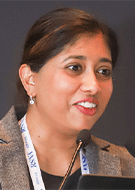New Informatics Tools are Helping Patients Understand Radiology Reports
Increased access for patients drives need for improved readability

Imaging informatics has the potential to facilitate communication between patients and radiologists and help patients better understand their radiology reports, according to a leading authority who spoke at RSNA 2019.
Historically, radiology reports have been prepared for primary care physicians and specialists to communicate information that will affect the next steps in patient care. More and more patients today are getting direct access to the reports through patient portals, where they are finding challenging language and radiology colloquialisms that they may be likely to misunderstand.
“As a one-way form of communication, the radiology report is not terribly helpful for patients,” said Tessa S. Cook, MD, PhD, assistant professor of radiology at the Perelman School of Medicine at the University of Pennsylvania in Philadelphia. “It doesn’t provide an opportunity for the patient to ask questions and get clarifications.”
Informatics presents an opportunity to design innovations that help patients better understand their radiology reports.
"One thing we’ve heard from patient advocates is that a conversation with the radiologist helps people better understand their condition or the condition of their family members, but they’re never given that opportunity and that’s frustrating."
Tessa Cook, MD, PhD
Many groups are actively working on ways to address this issue, Dr. Cook said. At the University of Pennsylvania, Dr. Cook and colleagues Charles Kahn, MD, and Seong Oh, MD, piloted an informatics system called the Patient-Oriented Radiology reporTER (PORTER) that automatically attaches definitions and illustrations to terms.
In the system, when the user drags their mouse over a complex word or term, a window pops up giving a definition written for the layperson. Public domain illustrations and annotations of anatomy and physiology linked to Wikipedia further augment the information.
“It helps make the radiology report less mystifying to patients,” Dr. Cook said. “They can review it at their leisure and then have the conversation with their physician about what comes next.”
PORTER also includes the name and a photograph of the interpreting radiologist as a way of communicating to the patient that there is a specialist behind the interpretation.
The system, originally created for knee MRI reports, has grown to include more than 14,000 terms. Additional pilot programs are underway in screening mammography and image-aided biopsy. The department hopes to have the system integrated into patient portals in early 2020.
Informatics also has the potential to help people more effectively connect with the radiologists caring for them or their family members. Several pilot programs are looking at virtual consultations with patients and other ways patients can review the information in the report with physicians.
“One thing we’ve heard from patient advocates is that a conversation with the radiologist helps people better understand their condition or the condition of their family members, but they’re never given that opportunity and that’s frustrating,” Dr. Cook said. “We want to find ways to create that opportunity.”
The radiology department at Massachusetts General Hospital in Boston piloted a virtual radiology consultation pilot program in 2016 that has grown to include five radiologists and more than 50 patients. Patients have responded favorably, with 90% saying the consultations markedly improved their health care experience.
Virtual Communication, Embedded Surveys on the Horizon
Active areas of research include virtual consultations with patients and other ways patients can review the information on the report with physicians.
Other ideas include embedding surveys into radiology reports so that patients can weigh in on the accessibility of the information in the report and the value of the interpretation. Informatics can help monitor follow-up recommendations, identify patients overdue for cancer screening and create imaging orders automatically to take the burden off the primary care physicians.
Dr. Cook and her colleagues have been exploring the use of Amazon Mechanical Turk, a crowdsourcing marketplace that allows users to survey laypeople for research purposes. Survey responders can serve as patient surrogates who look at actual radiology reports and offer feedback.
View a video interview with Dr. Cook at RSNA.org/News.